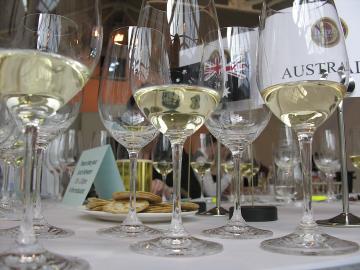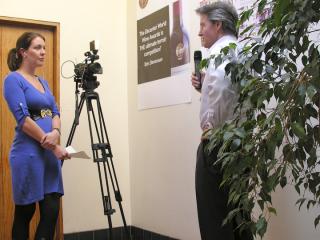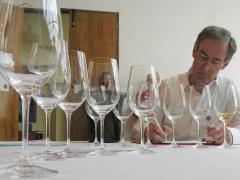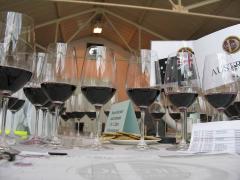Jurisprudence
POSTED ON 26/04/2009Mostly last week I have been judging wine. I was judging wine for the entire week in fact as one of the co-chairs, with Huon Hooke, wine correspondent of the Sydney Morning Herald, of Australian wine at the Decanter World Wine Awards. Other journalistic friends and colleagues meanwhile were doing exactly the same thing across the capital at the International Wine Challenge, the UK’s other meaningful wine competition.
 Aussie whites line up
Aussie whites line up
Are wine competitions a racket designed just to make money for their organisers and judges while handing out little bits of glory to the producers who win medals? There’s no doubt a body of opinion that believes this to be the case with stories in the press reinforcing the idea that competitions are just out for themselves and of no benefit to the consumer. Yet as David Williams points out in an astute and honest article in the World of Fine Wine, yes of course they’re a business, and often a lucrative one for their owners, but just because they’re a business doesn’t in itself neutralise their benefits.
Perhaps more to the point is the issue of just how professional the competitions are. A consumer may see a sticker on a bottle signifying a medal with no knowledge of how that medal came about, where it’s from and whether it means very much. That to me is the problem, because with the proliferation of wine competitions worldwide, any wine company can probably find at least one that will give them a medal of sorts and if the competition happens to be worthless, and some are, most consumers are none the wiser. There were 37 at the last count according to Meininger International and that excludes the likes of the Australian state shows.
It helps therefore to know which competitions are worthwhile. According to David Williams, the four most often cited in his ‘respect’ survey of top producers were: the Decanter World Wine Awards, the International Wine Challenge, the Sydney International Wine Competition and the Concours Mondiale de Bruxelles.
 Decanter's evergreen chairman, Steven Spurrier
Decanter's evergreen chairman, Steven Spurrier
I judge for Decanter, which I think is highly professional. Yes, I would say that. I get paid as a judge so I have an interest. But does that mean I’ll do anything I’m offered money for? I’ll leave you to be the judge of that. At Decanter, more than 10,000 wines are entered to be judged by experts in their field over a week’s judging at The Worx in Parsons Green. Wines are awarded trophy, gold, silver or bronze medals or commended, or thrown out. There are a handful of trophies and the average rate for medals is around 3% gold, 10% silver and 25% bronze, an indication in itself that the competition has high standards and only the crème de la crème end up with a gold medal.
The wines are judged blind and judged rigorously, each with a score out of 20. In an attempt to avoid palate fatigue and bigger wines standing out, the twin bugbears of wine competitions, no panel as far as I know judges more than 100 wines a day, and often it’s a fair bit less than that. It’s certainly true to say that as the week’s judging makes clear, the decisions are often nowhere near as clearcut as the results suggest. A panel of three, or four, will more often than not agree on a wine, but they’ll also frequently disagree on either the quality of a wine or whether they actually like it or not or both.
 Huon Hooke, Sydney Morning Herald, Aussie co-chair
Huon Hooke, Sydney Morning Herald, Aussie co-chair
Where a panel disagrees on a medal, whether the wine should be commended, or simply rejected, issues may be resolved by discussion and where they can’t be, the chair of the panel decides, or may call over the chair of the competition for a decision. Decisions are therefore often much more subjective than you might think, but then it would be a mistake to think that the results are set in stone. They are not. Wine is after all a living product, and what looks good today may fade or improve tomorrow, next week, next month, or a year later.
A second problem is the calibre of the entries themselves. Most countries and regions are keen to enter their wines, despite the investment of a £100+ a pop entry fee and the submission of five or six bottles for each entry, but you’ll often find that those with the most to lose are more reticent. So in France while Champagne is pretty good at entering its top wines (those guys have marketing budgets to die for), the ‘classic’ regions of Bordeaux, Burgundy and the Rhône are more reluctant. The same goes for Italy and Spain and even the New World, which in the past has had most to gain, but is starting to rein back a little on entering where producers feel that they have more to lose than to gain.
 Sarah Kemp, Decanter publisher and mother hen, administers a warning
Sarah Kemp, Decanter publisher and mother hen, administers a warning
And this past week? Huon Hooke and I were involved in overseeing four panels, which got through over Australian 1000 wines during the week. Australia’s strong suit is normally regarded as red and indeed, not unexpectedly, 10 gold medals were awarded to shiraz (we brought down two more golds to silver that we didn’t feel had quite the wow! factor, another indication that golds are not doled out like Smarties) and another six to Bordeaux-style blends. What really stood out this year though was the quality of the chardonnays, the rieslings and the stickies, Australia’s unique fortified wines from north-eastern Victoria.
 the reds line up
the reds line up
Two chardonnay golds apiece from Adelaide Hills and Yarra Valley and three from Margaret River in Western Australia gave a pretty good indication of where the chardonnay quality is coming from. The rieslings were mostly if not all Clare and Eden Valleys in South Australia, as you’d expect and the fortifieds from Rutherglen in north-eastern Victoria. There was one glorious 1998 semillon, but a shame not to see more of this uniquely Australian style coming through. Equally, the semillon sauvignon blends from Western Australia were good, but not good enough for gold medals. The biggest disappointments were pinot noir and sparkling wines with not a gold medal between them.
And the results? We don’t know them – yet. Judging is blind and we are told the vintage, region and broad price range, but not what the wines are. Every bottle is tightly sealed and not to be opened on pain of its, and probably our, expulsion. The results, international trophies apart (which are announced at the awards dinner in September) are revealed at the London Wine Fair on 12 May. I’ll keep you posted.
Wine of the Week
2005 Penfolds Bin 128 Shiraz, Coonawarra, Australia, £11.99, Tesco.com / Majestic. Something of a departure from the normal Penfolds regional blend house style, this shiraz is pure Coonawarra and aged in French oak so a tad more elegant than the norm, showing touches of mint, olive and pepper on the nose and a lovely seductively spicy rich black fruit quality that’s evidence of time still to go.

